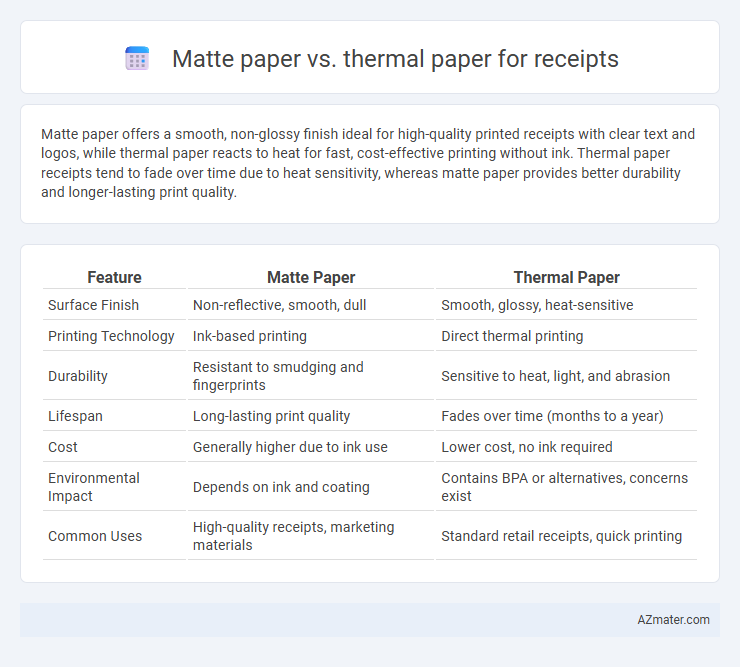Matte paper offers a smooth, non-glossy finish ideal for high-quality printed receipts with clear text and logos, while thermal paper reacts to heat for fast, cost-effective printing without ink. Thermal paper receipts tend to fade over time due to heat sensitivity, whereas matte paper provides better durability and longer-lasting print quality.
Table of Comparison
| Feature | Matte Paper | Thermal Paper |
|---|---|---|
| Surface Finish | Non-reflective, smooth, dull | Smooth, glossy, heat-sensitive |
| Printing Technology | Ink-based printing | Direct thermal printing |
| Durability | Resistant to smudging and fingerprints | Sensitive to heat, light, and abrasion |
| Lifespan | Long-lasting print quality | Fades over time (months to a year) |
| Cost | Generally higher due to ink use | Lower cost, no ink required |
| Environmental Impact | Depends on ink and coating | Contains BPA or alternatives, concerns exist |
| Common Uses | High-quality receipts, marketing materials | Standard retail receipts, quick printing |
Introduction to Receipt Paper Types
Matte paper and thermal paper are two common types of receipt paper used in point-of-sale systems. Matte paper offers a non-reflective surface ideal for handwriting and long-lasting printed receipts, while thermal paper uses heat-sensitive coating that reacts to thermal printers for fast, clear printing without ink. Choosing between these types depends on factors such as printer compatibility, desired receipt durability, and printing speed requirements.
What is Matte Paper?
Matte paper is a non-glossy, smooth paper type commonly used for receipts due to its excellent print clarity and resistance to smudging. It features a dull finish that enhances readability and reduces glare, making it ideal for detailed barcode and text printing. Compared to thermal paper, matte paper requires traditional ink printing methods and offers better durability under light exposure and heat.
What is Thermal Paper?
Thermal paper is a special fine paper coated with a chemical that changes color when exposed to heat, eliminating the need for ink or ribbons in receipt printing. It is widely used in point-of-sale systems due to its fast printing speed, cost-efficiency, and high-quality print resolution for barcodes and text. Thermal paper's heat-sensitive technology offers durability and smudge resistance, making it ideal for temporary receipts and quick transactions.
Printing Technology: Matte vs Thermal
Matte paper uses traditional ink-based printing technology, producing sharp, smudge-resistant text and images ideal for high-quality receipts. Thermal paper relies on heat-sensitive technology that activates a special coating to form text without ink, enabling fast and quiet printing with limited color options. Each method affects print durability and appearance, with matte paper offering better longevity and thermal paper excelling in speed and cost-efficiency.
Durability and Longevity Comparison
Matte paper receipts offer superior durability and resistance to smudging, making them ideal for long-term record keeping compared to thermal paper, which tends to fade or darken over time due to heat sensitivity. Thermal paper receipts, while cost-effective and fast to produce, have a shorter lifespan, often deteriorating within months when exposed to heat, light, or oils. Choosing matte paper enhances receipt longevity significantly, ensuring clearer, lasting records critical for audits and returns.
Cost Analysis: Matte Paper vs Thermal Paper
Matte paper generally incurs higher costs due to its coating and printing requirements, whereas thermal paper offers a cost-effective option thanks to its heat-sensitive technology, which eliminates the need for ink or ribbons. The lower operational expenses of thermal paper, including reduced maintenance and faster printing speeds, make it a preferred choice for high-volume receipt printing environments. However, the durability and print quality of matte paper may justify its higher initial investment for businesses prioritizing premium presentation and long-term archival.
Environmental Impact of Matte and Thermal Paper
Matte paper for receipts is typically coated with biodegradable or recyclable materials, reducing its environmental footprint compared to thermal paper, which often contains harmful chemicals like BPA or BPS that can contaminate recycling streams and soil. Thermal paper's chemical coatings hinder biodegradability, leading to longer decomposition times and increased environmental pollution. Choosing matte paper for receipts supports sustainable practices by minimizing toxic waste and promoting easier recycling and composting processes.
Print Quality Differences
Matte paper offers superior print quality for receipts with sharp, clear text and vibrant colors that resist smudging and fading over time. Thermal paper relies on heat-sensitive coating, producing fast, high-contrast prints ideal for short-term use but prone to fading and discoloration under heat or light exposure. Matte paper's durability and consistent print clarity make it preferable for receipts requiring long-lasting readability and professional appearance.
Ideal Use Cases for Matte and Thermal Receipt Papers
Matte paper suits printing receipts with detailed graphics or text requiring sharp, non-reflective clarity, making it ideal for retail stores, restaurants, and environments where readability under various lighting is crucial. Thermal paper excels in fast, high-volume transactions such as in supermarkets and gas stations due to its heat-sensitive coating that produces quick, cost-effective prints without the need for ink. Businesses prioritizing durability and smudge resistance prefer matte receipts, while those valuing speed and low maintenance often choose thermal paper.
Choosing the Right Paper for Your Business
Matte paper offers a non-reflective surface ideal for businesses needing durable, high-quality receipts with clear print that resists smudging. Thermal paper, popular for its cost-efficiency and fast printing via heat-sensitive technology, suits high-volume retail environments but may fade over time if exposed to heat or sunlight. Choosing the right paper depends on factors like print longevity, cost, printer compatibility, and the desired aesthetic for your business receipts.

Infographic: Matte paper vs Thermal paper for Receipt
 azmater.com
azmater.com